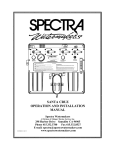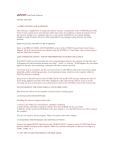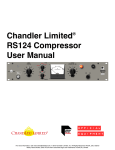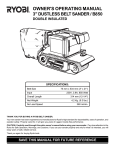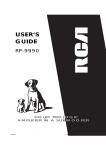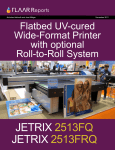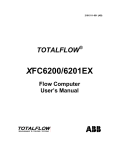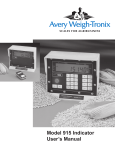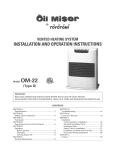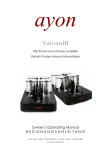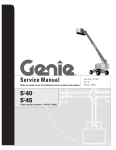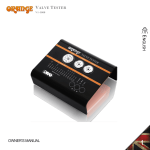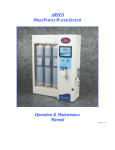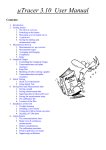Download AT1000 User Manual - Amplitrex Audio Products
Transcript
AT1000 Vacuum Tube Tester Operations Manual Applies to firmware version 2.12 and later 22 July 2009 TABLE OF CONTENTS 1.0 PRECAUTIONS AND WARNINGS 2.0 FRONT PANEL COMPONENTS 3.0 BASIC OPERATION 4.0 INTERPRETING RESULTS 5.0 TROUBLESHOOTING 6.0 EDITING TEST DATA AND ADDING TUBES 7.0 UPLOADING THE TEST DATA FILE 8.0 THE SYSTEM MENUS 9.0 USING THE CURVE PLOTTING SOFTWARE 10.0 BIASING AND TESTING MODES ============ 1.0 PRECAUTIONS AND WARNINGS WARNING: THE AT1000 VACUUM TUBE TESTER GENERATES AND USES HIGH VOLTAGE. FOLLOW ALL INSTRUCTIONS CAREFULLY. NEVER TOUCH OR REMOVE A TUBE WHILE TESTING OR CURVE PLOTTING IS IN PROGRESS. NEVER TOUCH ANY TUBE PINS, SOCKET CONTACTS, OR PLATE OR GRID CAP METAL PARTS WHILE THE UNIT IS CONNECTED TO A SOURCE OF AC POWER. UNPLUG THE UNIT WHEN NOT IN USE. IF A TUBE SOCKET IS BROKEN, THE METAL CONTACTS INSIDE IT MAY BECOME EXPOSED. IF THIS OCCURS, STOP USING THE UNIT AND HAVE IT REPAIRED BEFORE USING IT AGAIN. DO NOT USE THE UNIT WITH WET OR PRESPIRING HANDS. MOISTURE INCREASES THE RISK OF SHOCK AND ELECTROCUTION. NEVER INSERT ANYTHING EXCEPT A TUBE'S PINS INTO THE TUBE SOCKETS ON THE AT1000. CONTACT WITH HIGH VOLTAGE CAN CAUSE SERIOUS INJURY, CARDIAC ARREST OR DEATH. WARNING: THE AT1000 MUST BE CONNECTED ONLY TO AN AC POWER OUTLET THAT IS PROPERLY GROUNDED. DO NOT ATTEMPT TO DEFEAT THE GROUND CONNECTION BY USING ADAPTERS OR BY REMOVING THE GROUND PIN(S) FROM THE POWER CORD OR INLET. ELECTRICAL SHOCK, ELECTROCUTION, OR FIRE MAY RESULT. REPLACE THE POWER CORD IF IT BECOMES DAMAGED IN ANY WAY. WARNING: KEEP THIS UNIT OUT OF THE REACH OF CHILDREN. OPERATION BY NONTECHNICAL PERSONNEL MUST BE SUPERVISED CLOSELY BY A PERSON FAMILLIAR WITH THESE OPERATING INSTRUCTIONS, ESPECIALLY THESE WARNINGS, AND WITH HIGH VOLTAGE SAFETY IN GENERAL. DO NOT ALLOW CHILDREN TO OPERATE THIS EQUIPMENT. WARNING: VACUUM TUBES CAN BECOME EXTREMELY HOT DURING TESTING AND CURVE PLOTTING. DO NOT HANDLE HOT TUBES WITH BARE HANDS. ALLOW TUBES TO COOL FOLLOWING OPERATIONS BEFORE REMOVING THEM FROM A TEST SOCKET. USE PROTECTIVE GLOVES IF IT IS NECESSARY TO HANDLE HOT TUBES. NEVER REMOVE A TUBE WHILE POWER IS APPLIED TO IT UNDER TEST, OR DURING A CURVE PLOTTING OPERATION. SWITCH OFF THE POWER BEFORE INSERTING OR REMOVING A RECTIFIER TUBE (SOCKET H). WARNING: MOST VACUUM TUBES ARE CONSTRUCTED WITH GLASS ENVELOPES. IF ACCIDENTALLY BROKEN, GLASS FRAGMENTS WILL BE SHARP AND CAN CAUSE CUTS OR OTHER INJURY. CLEAN UP BROKEN TUBE PARTS CAREFULLY, USING PROTECTIVE GLOVES. BE AWARE THAT SOME TUBES MAY CONTAIN SMALL AMOUNTS OF HAZARDOUS MATERIALS. IN THIS CASE, CONSULT THE TUBE MANUFACTURER'S MSDS FOR FURTHER INFORMATION. CAREFULLY WRAP BROKEN TUBE FRAGMENTS IN HEAVY PAPER AND DISPOSE OF IN TRASH. DO NOT BREATHE ANY POSSIBLE DUST OR FUMES. A TUBE CONTAINING MERCURY, SUCH AS A MERCURY VAPOR RECTIFIER, PRESENTS A HEALTH HAZARD IF BROKEN. CONTACT LOCAL EMERGENCY AUTHORITIES IF A MERCURY CONTAINING TUBE IS BROKEN. DO NOT ATTEMPT TO CLEAN IT UP YOURSELF WITHOUT THE PROPER EQUIPMENT, PERSONAL PROETCTIVE GEAR, AND PROCEDURES. DISCONNECT POWER FROM THE UNIT, AND MOVE TO FRESH AIR IMMEDIATELY IS A MERCURY CONTAINING TUBE IS BROKEN. IF A TUBE GLASS ENVELOPE BREAKS WHILE IT IS PLUGGED INTO THE AT1000, DISCONNECT THE UNIT FROM ITS SOURCE OF AC POWER AS SOON AS POSSIBLE. WAIT AT LEAST 2 MINUTES FOR ALL HIGH VOLTAGE TO BE DISCHARGED (AUTOMATICALLY, BY BLEEDER RESISTORS IN THE UNIT) BEFORE ATTEMPTING TO REMOVE THE REMAINS. BE CAREFUL OF SHARP GLASS AND HOT FRAGMENTS. PLIERS MAY BE USEFUL IN REMOVING BROKEN TUBE BASE FRAGMENTS IN THE CASE OF MINIATURE TUBES. WARNING: THE AT1000 CONTAINS FUSES AND A THERMAL PROTECTIVE DEVICE. DO NOT REPLACE WITH OTHER THAN IDENTICAL COMPONENTS OR BYPASS THESE SAFETY DEVICES. DOING SO WILL VOID YOUR WARRANTY AND MAY RESULT IN FIRE, DAMAGE TO OR LOSS OF PROPERTY, AND PERSONAL INJURY OR DEATH. DO NOT ATTEMPT REPAIR OF THE UNIT YOURSELF. RETURN A DEFECTIVE UNIT TO THE FACTORY FOR REPAIRS. WARNING: DO NOT EXPOSE THE UNIT TO MOISTURE, RAIN OR OTHER LIQUIDS. DOING SO VOIDS YOUR WARRANTY AND MAKES THE UNIT UNSAFE TO OPERATE UNTIL REPAIRED BY THE FACTORY. FIRE, PROPERTY DAMAGE AND PERSONAL INJURY OR DEATH MAY RESULT FROM THE OPERATION OF A UNIT THAT HAS BEEN EXPOSED TO MOISTURE. IF THE UNIT HAS SUFFERED DAMAGE IN SHIPPING, HAS BEEN DROPPED OR OTHERWISE OBVIOUSLY DAMAGED, DO NOT CONNECT IT TO A SOURCE OF AC POWER. RETURN IT TO THE FACTORY FOR INSPECTION AND REPAIR. WARNING: DO NOT OBSTRUCT VENTILLATION OPENINGS. ENSURE THAT THE COOLING FAN IS OPERATING, AND VENTILLATION OPENINGS ARE UNOBSTRUCTED BEFORE BEGINNING OPERATIONS. DO NOT ALLOW ANY FORIEGN SUBSTANCE OR OBJECT TO ENTER ANY OPENINGS. CONTACT WITH HIGH VOLTAGE MAY RESULT, CAUSING DAMAGE OR DESTRUCTION OF PROPERTY, AND POSSIBLE INJURY OR DEATH DUE TO FIRE OR ELECTROCUTION. WARNING: DO NOT INSERT A TUBE UNTIL THE TEST HAS BEEN SET UP (EXCEPTION: RECTIFIERS), AND THEN ONLY INSERT THE TUBE INTO THE CORRECT SOCKET. DO NOT INSERT MORE THAN ONE TUBE AT A TIME. DAMAGE TO THE AT1000 OR THE TUBE(S) MAY RESULT. DO NOT ATTEMPT TO TEST A BROKEN TUBE, OR ONE WHERE THE GETTER FLASH (NORMALLY SILVER IN COLOR) HAS TURNED WHITE. WARNING: THE RECTIFIER TUBE TEST SOCKET, SOCKET H, HAS HIGH VOLTAGE AC WIRED TO PINS 2 AND 4. THIS VOLTAGE IS PRESENT WHENEVER THE UNIT IS SWITCHED ON, EVEN IF A TEST IS NOT IN PROGRESS. IT IS RECOMMENDED THAT THE UNIT BE SWITCHED OFF BEFORE RECTIFIER TUBES ARE INSERTED OR REMOVED FROM SOCKET H. THIS WILL MINIMIZE THE POSSIBILITY OF CONTACT WITH DANGEROUS VOLTAGE, SHOULD THE TUBE BREAK WHILE INSERTING/REMOVING, OR IF FINGERS COME INTO CONTACT WITH LIVE PINS. CAUTION: INCORRECT TEST SETUP, OR INCORRECT SELECTION OF TUBE TYPE OR TEST SOCKET CAN DAMAGE THE TESTER AND DAMAGE OR DESTROY A TUBE. AMPLITREX AUDIO PRODUCTS ACCEPTS NO RESPONSIBILITY FOR TUBES WHICH MAY BE DAMAGED DURING TESTING. ============= 2.0 FRONT PANEL COMPONENTS TUBE SOCKETS The unit is equipped with 8 high quality tube sockets. Each socket is identified with a letter of the alphabet, A through H. During test setup, the LCD screen tells the user which socket to use. Some users may elect to use socket savers, to prolong the life of the sockets in the AT1000. This is an especially important consideration if large numbers of tubes are to be tested, such as in a manufacturing or large batch matching operation. LCD DISPLAY The backlit LCD display contains four lines of 40 characters, each. By observing the display, the user is guided through mode and tube selections, shown test setup information, instructed which socket to use, and shown the test results. MENU NAVIGATION KEYS AND ENTER KEY Using these five tactile-feedback keys, the user navigates through the menus and makes selections, as guided by the LCD Display. The ENTER key is used to make a selected option active, to confirm an operation, and finally begin the actual test. The left arrow [<] key is used to abort a test, or to go back to a previous menu. The other keys are used to navigate up, down, and left and right in the List of Tube Types, or to navigate through the System Menus. AC INLET AND POWER SWITCH The unit is shipped wired for 115V or 230V, AC 50 or 60 Hz operation. Verify that your unit is wired for the correct voltage before connecting it to a mains source. Connect the supplied AC line cord to the AC inlet on the AT1000, then plug the opposite end into a grounded outlet. In countries other than the United States, the use of an adapter or special power cable may be necessary. Use the power switch to power up the unit, or to shut down after testing operations are concluded. Always switch OFF the power switch when you have completed a tube testing session. Disconnect the AC power cord from the outlet if the unit will not be used again shortly. RS232 SERIAL CONNECTOR This standard 9-pin D connector links the AT1000 to a personal computer serial port. Use the provided, standard, male-to-female cable wired pinfor-pin for this connection. Connect this cable whenever uploading a new Test Data File or performing curve plotting and tube testing with a personal computer. It is also possible with firmware after V1.20 to update the firmware over the serial port. The cable (and a computer) is not needed for tube testing in the “Stand Alone” Mode. PLATE AND GRID CAP BANANNA JACKS These jacks are for use when testing tubes that have a plate or grid cap on them. Use the appropriate supplied cap lead (each accommodates a different cap size) when testing tubes with caps. Connect the lead to the appropriate jack (plate or grid) as instructed by the LCD screen. Never touch the metal parts of the plate cap or the banana plug or jack. Handle them only by touching the insulated plastic and ceramic parts. Never connect or disconnect them while a test is in progress, only when instructed to by the LCD display, or when the Test Menu has been exited (heater turns off). AUDIO OUT CONNECTOR AND VOLUME CONTROL The Audio Out connector is a standard, 1/4" Stereo jack. You can connect headphones or a speaker, or an oscilloscope or AC voltmeter here. The Volume Control, a small knob located on the left side of the panel, controls the level of signals present at the Audio Out connector. ============ 3.0 BASIC OPERATION IN STAND ALONE MODE The AT1000 is very easy to use. Follow these instructions to test a tube. 1) Plug the unit into a source of AC power. Set the Power Switch to ON. The fan will start and the firmware version is displayed momentarily. The settings for Biasing Mode and Test Duration are displayed. Then, a list of tube type numbers appears. 2) Use the [UP] [DOWN] [LEFT] and [RIGHT] arrow keys to move the cursor, and navigate to the following screens. The [LEFT] and [RIGHT] keys move the cursor along each line, and up or down a line when the extremes of a line are reached. Use the [UP] and [DOWN] arrow keys to go to the previous or next page. The tube types are arranged alphanumerically, with numbers coming before letters. This means a 6550 will be found earlier in the list than a 6AQ5. The European letter prefix tubes like the ECC83 are listed after all the tubes that start with a number. Tubes like the 6CA7/EL34 are listed in both places, under 6CA7 and also EL34. The test setup is identical no matter which one is selected. When the cursor is position on the tube type number you want to test, press the [ENTER] key. 3) A screen is presented which shows some of the basic parameters of the test setup for the selected tube type. Press [ENTER] again to confirm this is the tube you want to test. 4) Next, you will be prompted as to which socket on the AT1000 to insert the tube into. Carefully insert the tube into the indicated socket and press [ENTER] again. If the tube you are testing requires a Socket Adapter, a screen will appear telling you that an Adapter is required, and which Socket on the AT1000 you should connect the Adapter to. Tubes in the Tube List with an Asterisk (*) require the use of a Socket Adapter. Refer to the specific Adapter Instruction Sheet for further information. If the tube you are testing has a plate or grid cap, another screen will appear advising which banana jack (plate or grid) to plug the cap/lead into. If this is the case, connect the cap lead and then press [ENTER]. It is not possible to test a tube that has two caps. 5) At this point, the test will begin automatically. The heater will be ramped up to its specified voltage, and a timer will count down. When the counter reaches zero, the Warmup phase ends, the Heater-to-Cathode Leakage Test is done, and then B+ is applied to the tube. 6) B+ comes on, and this is indicated on the LCD screen. The tube is biased into conduction in one of two modes. In Auto Bias Mode, the grid voltage is adjusted downward automatically until the specification plate current is achieved. In Fixed Bias Mode, the specification bias voltage is applied to the grid, and the plate current will be whatever results at this bias setting. The user can change the Bias Mode by using the System Menus (see section 8.0). 7) Once the plate current is flowing, the unit will proceed automatically to test the transconductance (if it is in Timed Test Mode). If the unit is configured for Manual Test Mode, the user is prompted by the LCD display to “Press ENTER to continue”. This allows the user to wait until plate current stablizes, if desired, before continuing with the Transconductance Test. The user can change the unit between Timed and Manual Test Modes by using the System Menus (see section 8.0) A 1 kHz sine wave is applied to the grid of the tube. The AC plate current is measured, and the tube's transconductance is calculated and displayed. Firmware Version 2.08 and later displays updated Plate and Screen Current while the Transconductance is being measured. This increase in Plate Current, which is normal, is due to the fact that the tube is amplifying a 1kHz signal. The Plate Current is measured for the Results Screen BEFORE the 1 kHz signal is applied, so that an accurate Measured Plate Current reading is obtained. If the unit is set for Timed Test Mode, it will measure and average transconductance for 8 seconds, and then move on to the next (gas) test. If the unit is configured for Manual Test Mode, it will prompt the user with the “Press ENTER to continue” message. This is useful if you want to see if the transconductance drifts over time. In Manual Test Mode, the unit will stay in the mode of measuring transconductance and displaying it, until ENTER is pressed. When the transconductance test ends, the 1 kHz test signal is turned off. 8) Next the Gas Test begins. For the gas test, two plate current measurements are made. One is made a fraction of a second after the 1 kHz grid signal is removed. Then, the grid circuit resistance is increased 10X, and a few seconds are allowed to elapse. Finally, the second plate current measurement is made (which is frequently higher). The difference in these two readings becomes the Gas Result Value, and indicates the effect of the tube's gas contents (or other source of leakage to the grid) on its grid electrode. The Gas Test always operates automatically, there is no difference between Timed and Manual Test Modes. 9) After the gas test concludes, B+ is removed from the tube and the Test Results Screen is displayed. If there is more than one section in the tube under test, the other section(s) are tested before the results are shown. Each section of a multiple-section tube is tested as if it was a separate tube, and the results are shown separately for each section. If the unit is set to Manual Test Mode, the ENTER key must again be pressed to move from the Bias Function to the GM test, and again to move from the GM test to the Gas test. This is repeated for each section of the tube as it is tested. 10) Review the results. Use the [UP] and [DOWN] keys to move between the results screens for each tube section. If the tube is only a singlesection type, only one screen of results will be displayed no matter if the [UP] and [DOWN] keys are pressed. 11) To test the same tube again, just press [ENTER]. The unit will ask you if you want to re-test the tube. Press [ENTER] once more to repeat all tests. The heater is already on so there is no need to repeat the warmup. After the tests complete, the new results are displayed. Each time the test is repeated, the old results are replaced by the new results. 12) Press the [<] key to exit the test back to the setup screen for the tube. The heater will now turn off (NOTE: a second press of the [<] key will be necessary in the case of rectifier tubes). Allow the tube to cool, and then carefully remove it from its socket. For rectifier tubes, it is recommended that the POWER switch be turned off before the tube is removed from its socket. Using a circular rocking motion while pulling gently upwards helps to remove a tube without damaging the tube’s pins or the socket. Another of the same type of tube can be placed into the same socket and the test repeated (including heater warmup) by pressing the [ENTER] key. The exception to this is rectifier tubes, which will require selecting the tube type from the list again. 3.1 NOTES ON TESTING a) After the [ENTER] key is pressed in Step 4, no user action is required until the test concludes at Step 10, UNLESS THE UNIT IS SET TO CONTINUOUS (MANUAL) TEST MODE. In Manual Test Mode, the user must be careful when testing high power tubes, as the B+ regulators in the unit are subject to overheating. Should they overheat, B+ will be turned off and a message to this effect will be displayed on the LCD. For more information, see section 5.2. b) The user can bypass the remainder of the heater warmup (after the ramp interval) by pressing [ENTER]. Normally, you should allow the complete warmup time to elapse and not use this function. c) During bias adjustment, plate current may over- or under-shoot slightly. This has virtually no effect on test results and is caused by slight instabilities or noise in some tubes. Some tubes will appear to be more stable after they have been run for a while. The Manual Test Mode allows a longer run time for the tube than does the Timed Test Mode. d) Any time B+ is applied to the tube, the AT1000 protects itself by shutting down if a short or overload condition occurs. In this case, the user is notified by a message that a short or overload has been detected. The user can either restart the test or bail out back to the Test Setup menu. If a second attempt at testing a tube causes another short/overload shutdown, the tube should be considered defective and disposed of. The rectifier test does not shut down if there is a short, however, the forward and reverse voltage drops will indicate the defect. e) If the unit’s pass transistor heatsink overheats during operation, a message to this effect will be displayed to the user. Allow the unit to cool before attempting to resume operations. Make sure that the fan is operating and that the ventilation openings are not obstructed. Overheating will normally not occur except during prolonged, continuous operation above 70 mA iP at plate voltages below 300V. The rectifier test load resistors share the same heatsink, so extended rectifier testing may also cause overheating. 3.2 NOISE AND MICROPHONICS TEST During the part of the tube test where B+ is applied and plate current is flowing but the transconductance test has not yet started, you can listen to tube noise. You must select the Continuous (Manual) Test Mode (see section 8.0), so that the Headphone Amplifier is enabled. Connect a 4 to 32-ohm stereo headphone (not included) to the 1/4” Audio Out connector on the panel. Use the Volume Control on the left side of the panel to control the volume. The audio is muted during the B+ ramp-up and plate current stabilization periods, and when the Transconductance and Gas Tests are running. The Noise and Microphonics Test is useful for identifying preamplifier tubes that are microphonic. Tap gently on the tube envelope with a pencil or small screwdriver handle, and listen for any excessive ringing noise. A slight noise when tapping on the tube is normal. Higher gain tubes will usually exhibit greater microphonic noise. You can listen to power tubes as well, but use caution. They will make very loud noises when struck gently, due to their much larger physical structures. They also get hot quickly. Turn the volume up carefully from zero (fully counter-clockwise) to avoid hearing damage. The microphonic effects encountered with power tubes are generally of little concern, as they are normally used in the final (and lowest overall gain) stages of amplifiers. Nevertheless, you may want to choose tubes with the lowest levels of microphonics. Some background noise and hum will be heard as well. Some of the noise comes from the tube, and some from the AT1000. This is due to the unshielded nature of the internal tube socket wiring. 3.3 USING A SPEAKER INSTEAD OF HEADPHONES You can connect a 4 to 16-ohm speaker to the Audio Out connector, using a standard 1/4” stereo phone plug, and some wire. Connect the two hot terminals (tip and ring) of the plug together, and to one lead of the speaker. Connect the other speaker lead to the Common (sleeve) terminal on the plug. Make sure that the hot terminals and the Common terminal do not touch when re-assembling the plug and shell. You can also connect an oscilloscope or AC voltmeter instead of a speaker, by using a stereo phone plug wired as above. ======================== 4.0 INTERPRETING RESULTS After each series of tests concludes, B+ is switched off, heater power is maintained and test results are displayed on the LCD display. If a tube has more than one section, such as the 12AX7 Dual Triode, tests will be conducted on both sections of the tube. In the case of a 6T8 tube, there are four sections. Each is tested individually and the results appear on a separate screen. Use the [UP] and [DOWN] arrow keys to review the test results for each section of a multi-section tube. If there is only one section in the tube, the [UP] and [DOWN] arrow keys will only show one results screen. If, while in Manual Test Mode and during the Transconductance Test, the ENTER key is pressed before the “Please wait” message disappears, the transconductance result displayed will be zero. To prevent this during Manual Test Mode, wait until the “Please wait” message is replaced with “Press ENTER to continue”. 4.1 TYPES OF RESULTS DISPLAY SCREENS There are four different types of Results Screens. The first one is displayed if the tube (or tube section) is a triode, tetrode or pentode. It shows the following data: a) Top Line: Heater-to-Cathode Leakage. This is shown in microamperes, and is tested by applying -200V to the heater while the cathode is held at ground potential. Current is limited to 1 mA. Normally, a good tube will show zero leakage, but a few microamperes is probably OK. Heaterto-cathode leakage is critical for a preamp tube or a tube used in a cathode follower or in a cascode circuit. It is less critical for a power output tube or one that has its cathode tied to ground in the circuit. b) Second Line: This shows the specification values of grid voltage (in Auto Bias Mode) or plate current (in Fixed Bias Mode) and transconductance (GM), which is displayed in milliamperes-per-volt. Multiply by 1000 to convert mA/V into uMHOs. c) Third Line: This line shows the actual values of grid voltage (in Auto Bias Mode) or plate current (in Fixed Bias Mode) and the transconductance that were measured during the test. See section 10.0 for a description of the difference between Auto Bias and Fixed Bias. In Auto Bias Mode, if the actual grid voltage is less than specification, this means that the emission of electrons from the cathode was weaker than expected and a correspondingly lower grid voltage was required to establish correct plate current. In Fixed Bias Mode, if the actual plate current is less than specification, this also means that the emission is weak. In Auto Bias Mode, if the actual grid voltage specification value, this means that the tube can be expected to have a good amount of life grid voltage is very low or is zero, the tube was higher has strong remaining. is bad and than the emission and If the actual should be replaced. In Fixed Bias Mode, if actual plate current is greater than specification, this also indicates the tube has strong emission. And if actual plate current is very low or zero, the tube is bad and should be replaced. Some tubes of modern manufacture may show lower than “normal” grid voltage (in Auto Bias Mode) or lower than normal plate current (in Fixed Bias Mode), as some new tubes are not being manufactured to the same standards as they were in the vintage years. The actual measured transconductance is shown on the right side of the third line of the display. This value is determined by actually making the tube amplify a 1 kHz sine wave signal, and then measuring the AC plate current that results. A reading of one milliampere per volt means that with a one volt RMS AC grid signal, a one milliampere RMS AC current was observed in the tube. Transconductance normally reads close to the specification value. If transconductance reads low, this means that tube gain may be less than that expected in its application circuit. If it reads higher than the specification, more gain can be expected in the target circuit. If emission was low (low measured grid voltage or low measured plate current), the transconductance can be expected to possibly (but not always) be low as well. Note that the transconductance and emission values obtained with the triode DC amplifier section of an electron ray tube may read very low. This does not necessarily mean the tube is defective. This is because these parameters are not closely controlled in these types of tubes. d) Fourth Line: This line shows three things. On the left, a percentage of Emission is shown. 100% is displayed if the tube has emission that matches the specification value. 80% means that the tube has only 80% of the emission specified in the data sheets. A tube with an emission of greater than 100% shows that the tube has good emission, and should be expected to perform well in the application circuit. In the center of the fourth line, a percentage of Transconductance is shown. 100% means that the GM of the tube was the same as shown in the data sheets. A reading of less than 100% means that the tube’s transconductance is only that percentage of what the data sheet shows. As for Emission, a GM percentage over 100% shows that the tube is performing better than specification. The percentage values shown makes it easy to tell at a glance whether the tube is good, weak or excellent. You may ask, what constitutes a “good” tube? Well, this is difficult to say, and depends more upon your own criteria. In the days when vacuum tubes were the mainstay, most component values and supply voltages could be off as much as 20%, and the equipment would still work satisfactorily. You can apply this rule to a minimum acceptable Emission and Transconductance of 20% low, or a display of 80%. Tubes showing emission or GM less than about 70% can be classified as bad. However, you must be the one to determine for yourself if a tube with 70% emission or GM is suitable for use or not. For example, a tube showing 70% may perform very poorly in one piece of equipment, yet be OK in another. The third item displayed on the fourth line is the result of the Gas Test. During the Gas Test, the grid circuit source impedance is increased 10 times. Plate current is measured before, and then again after the impedance is altered. If there is residual gas inside the tube, the ion current flowing in the gas between the plate or screen and the grid causes the grid to become more positive (less negative). This produces an increase in plate current, this difference is the value that is displayed (in milliamperes). When interpreting Gas Test results, one must take into consideration several things. First, the normal plate current. Second, what is the application of the tube? And third, how much gas-induced current increase was measured. In the case of a small preamp tube like a 12AX7 or EF86, anything more than 0.1 milliampere of gas current will likely cause problems in the application circuit. Noise may be excessive, and/or the tube may not establish its correct operating point. With a power tube like a 6L6, the interpretation must be different. Power tubes typically show a few milliamperes of gas-induced current increase, even if they are good. This is because in these tubes, plate temperatures are generally much higher and there is more surface area on the plate and other tube components which naturally outgass somewhat as it heats up. Also, because these tubes normally operate with several tens of milliamperes, or even over 100 milliamperes, a few mA of Gas current is OK. With power tubes, a gasinduced current increase of less than 10 percent of normal plate current is OK in most application circuits. When performing repeated tests (hot retest) on a power tube, the re-application of plate current to an already-hot tube sometimes causes even MORE gas-induced current to be measured the second time. If the amount of current increase is more than about 10 percent of the tubes normal plate current, it is likely to produce noise in the circuit as well as a possible "run-away" condition. Whether or not this will happen depends on factors such as grid circuit impedance in the target application, and the values of plate voltage and current the tube is being run at. Occasionally, a run-away condition will result while the tube is in the AT1000, and this will cause an overcurrent shutdown and the message "possible excessive gas" to be displayed. 4.2 DIODE RESULTS SCREEN In the case of tubes that contain diodes or diode sections, such as the 6AL5 and 6T8, the Diode Results screen will be displayed. In addition to the Heater-to-Cathode Leakage measurement that appears on the top line, a reading for forward and reverse current is shown. Normally forward current should be in excess of 900 microamperes and reverse current should be zero. The test current is limited to 1 mA, and this reading may only be seen in a shorted diode, where the forward and reverse currents are almost the same. Also, heater-to-cathode leakage in diode sections is usually very critical, because the cathode is frequently a signal point in the application circuit. Heater-to-cathode leakage in diode sections should always read zero, a reading of a microampere or two (or more) is probably reason for the user to discard the tube as bad. There is no gas test for diode sections. If the tube contains a triode (or pentode or tetrode) section as well, the gas test will run only on the non-diode sections. 4.3 ELECTRON RAY INDICATOR RESULTS SCREEN Electron Ray Indicator tubes, such as the 6E5 and EM84, can be tested on the AT1000. In these cases, a special test is run on the display section of the tube. During the test, the tube's fluorescent screen will light up, and the shadow will be moved as the AT1000 varies the Ray Control Electrode voltage. The user should observe the fluorescent screen on the tube under test, and evaluate the brightness and shadow movement for normal appearance. Note that there is sometimes significant “shadow overlap” as the AT1000 delivers full B+ to the ray control electrode as would happen in normal operation of the DC amplifier triode section (if so equipped) when it was fully cut off. Once the tests conclude, the Results Screen for the Indicator Section will show the maximum achieved target current in the tube. Target current varies as the shadow moves, because more or less electrons are striking the target. Normal peak target current is a milliampere or two for most tubes. Many Electron Ray Tubes also have a triode section as well, which is used as a DC amplifier in the application circuit. Such triode sections are tested just like any other triode, for emission, transconductance, heater-to-cathode leakage and gas. Some tubes, such as the EMM801 have two separate display sections and two triode DC amplifier sections. All of these are tested independently and the results are shown on separate Results Screens. Note that the transconductance of DC amplifier triode sections in Electron Ray Indicators is usually very low. Sometimes it is as low as 0.05 or 0.1 mA/V. If such a tube is suspect, the user is advised to try it in an application circuit to see if the shadow movement is adequate. Do not rely on the Transconductance percent indication alone for Electron Ray Indicator tubes' triode sections. 4.4 RECTIFIER TUBES In the case of full wave rectifiers, such as the 5U4, 5Y3 and GZ34, a specialized results screen is displayed. It shows the measured forward and reverse voltage during the test, for both sections. The results for both sections are shown on the same screen, and there is no need to move between sections with the up and down arrow key. During the rectifier test, a sinusoidal voltage of 275V RMS (nominal) is applied, 180 degrees out of phase on each plate. This is how these tubes are generally run in an application circuit. Series load resistors are provided in each plate’s circuit, and the voltage drop between each plate and the cathode is measured. In case a tube is shorted, the load resistors prevent damage to the tester by harmlessly dissipating the reverse-conducted current. Normally, rectifier tubes will read between 10 and 70 volts forward drop, depending on the rating of the tube. Mercury rectifiers read the lowest, and small, high vacuum types such as the 5Y3 read the highest. The appropriate tube data sheet should be consulted to determine the expected forward drop at a peak current of about 100 mA. The reverse voltage drop should be much higher, typically between 390 and 405 volts, peak. The actual reading will vary with local mains voltage and the amount of mains waveform distortion that is present. 4.5 MATCHING TUBES Vacuum tubes can be matched for use in balanced circuits, such as pushpull output or fully-differential preamplifier use. Single-section tubes can be matched to each other, and dual section tubes can have their sections matched as well as establishing a match between tubes. Tube matching generally consists of testing a number of identical tubes, and then grouping them by one or more tested parameters. Tubes can be matched by emission, transconductance, or both. If only one parameter is to be matched, it is recommended that emission is selected. For power output tubes, some amplifiers have DC and AC balance controls. These controls can null out some of the variance in tube parameters. In parallel (SEP) and push-pull parallel power tube operation, close matching is essential for maximum performance. There are generally no separate bias and drive controls when tubes are run in parallel, and if the tubes don't share the AC and DC loads symmetrically, power output and distortion will suffer greatly. Differential audio and instrumentation amplifiers achieve best performance when matched tubes are used. Quite often, miniature dual triodes are employed. These can have their sections matched, or all the tubes in a signal chain can be matched. The circuit topology dictates which is more important, but full matching for this type of equipment guarantees best performance. To match tubes by emission, use the Fixed Bias Mode, and compare the resulting plate currents measured during the test. The closer the values, the better the match. In push-pull power output stages, the emission match should be within 5% if there is no DC balance control or separate bias adjustment for each tube. Even with these adjustments, closely matching the emission of each tube greatly improves performance and long-term reliability. To match tubes by transconductance, first make sure that the emission is within 10% for the tubes. Then compare transconductance readings between tubes for a 5% or better match. For preamplifier tubes, emission and transconductance matching can also improve performance. Particularly in “long tail pair” phase splitter operation, the tubes or tube sections should be closely matched. If the phase splitter is operating as symmetrically as possible, distortion will be reduced, and drive to the output stage will increase. Sometimes there are driver tubes after the phase splitter but before the output tubes. These tubes should also be matched, so that drive to the outputs remains as symmetrical as possible throughout the signal path. Fully differential preamplifiers often used in the recording industry will be push-pull from input to output transformers. Keeping things balanced throughout the signal path is essential to take advantage of the wide bandwidth, low noise and low distortion this equipment is capable of. 4.6 WARMUP AND OTHER FORMS OF DRIFT In electronics, even vacuum tube electronics, it is nice to keep things consistent and under control. With well-designed circuits, running the tubes well within maximum ratings, one can expect stable operation. Occasionally, tubes will exhibit various types of drift. The most common type of drift is caused by the heater-cathode assembly in the tube. It often gets worse as the tube ages. Most often, this form of drift takes place over several minutes or tens of minutes, and starts out as low emission gradually rising as time passes. At some point the upwards emission drift diminishes to zero, and the tube becomes stable. Generally, it is desirable for power tubes to warm up fully in one to two minutes. Smaller tubes can be expected to stabilize in as little as 30 seconds. Directly-heated tubes generally exhibit stable emission in only 15 to 30 seconds. As a tube ages, the cathode oxide coating used in most tubes becomes worn out. It can also be damaged by heater undervoltage, overvoltage, or too much emission current. Not to mention the effects of residual gas and air left in the tube. The effect of this aging and damage is a “slow-to-warmup” tube. These tubes also generally exhibit low ultimate emission, and lower than normal transconductance. Another form of drift manifests by physical distortion of tube electrodes and their spacing, caused by heat or selective electron bombardment. These causes can make emission and/or transconductrance drift up OR down as the tube operates. Sometimes the drift is random in either direction, even after hours of warmup time. After many years of operation, some tubes end up with severely distorted electrodes which produce various nonlinearities and drift radically during operation. The warping can even get so extreme that short circuits can develop between electrodes. Other tubes, often vintage military specification tubes, are conservatively designed and well constructed, and remain stable even after many thousands of hours of operation. Equipment that operates its tubes at or near the Absolute Maximum Ratings is more likely to cause heat-damage to its tubes over time. Drift can be measured by using the Manual Test Mode, where any such drift is apparent over time. Just be careful with power tubes, as they can cause the AT1000 B+ regulators overheat in just a few minutes. ===================== 5.0 TROUBLESHOOTING Refer to this section if you are having difficulties with the AT1000. 5.1 Tube tests bad, with no or very low emission or transconductance. Try a known good tube in the unit. If a known good tube tests bad, the AT1000 may have a problem requiring repair. 5.2 Test always cuts off showing "possible short" or "excessive gas". Try the test without a tube in the socket. If it shuts down again with errors about shorts or gas, there may be a problem requiring repair. If B+ stays on without the tube, then the tube was defective. 5.3 Heater or Filament inside tube does not light. The Heater or Filament could be burned out. Try another tube. If the problem persists, contact the factory for instructions. 5.4 LCD Display backlight does not light, fan does not run. Blown fuse inside the unit. Contact the factory for instructions. 5.5 Plate Current (iP) increases during the Transconductance Test. This is normal. Firmware Version 2.08 and later displays updated Plate and Screen Current while Transconductance is being measured. The increase in Plate Current is due to the fact that the tube is amplifying a 1kHz signal. The Plate Current is measured for the Results Screen before the 1 kHz signal is applied, so that an accurate Measured Plate Current reading is obtained. 5.6 Unable to upload a new Tube Test Data File. Make sure that you have configured the Tubedata Editor Software for the COM port that you are using. Make sure you are using a known good, pin-for-pin wired serial cable. Make sure that the AT1000 is in the Upload Mode (see Section 7 of this manual). Make sure that the data file is in the correct directory, and that it is not corrupt. You can view a .CSV file using Notepad. 5.7 Unit overheats frequently Make sure that the ventilation openings are not obstructed by objects or dust. Clean if necessary. Make sure that the fan is running when power is applied and the unit is switched on. Continuous re-testing or using in Manual Test Mode for too long, with a high power tube, may eventually cause the unit to overheat. Allow more time between tests, or operate at a lower plate current for burn-in testing. If the problem persists, contact the factory. ======================= 6.0 EDITING TEST DATA AND ADDING TUBES The AT1000 is shipped One of these files is test setup data which the Version Number of along with a CD-ROM which contains several files. TUBEDATAxxx.CSV. This file contains all of the the AT1000 uses for testing tubes. (xxx represents the TubeData File). TUBEDATAxxx.CSV is a Comma Delimited File. We recommend that you open and edit the file with using Notepad®. You can also edit the file using TubeData Editor. See the separate instructions if you intend to edit the file using this program. If editing it with Notepad, make sure to save the file as plain text with the .CSV filename extension. The user is advised to save a copy of the TUBEDATAxx.CSV file, in a safe place. This way, in case the "working" copy is damaged, lost or becomes corrupted, you can retrieve the original file(s). Editing the file is easy. When using Notepad, you will see a series of lines of text. Each line is called a Record, and is comprised of exactly 15 data Fields, each separated by a comma. Each Record contains the test data for one tube, or in the case of multi-section tubes, the test data for one section Note that some of the data in some of the fields contain leading zeros. It is EXTREMELY IMPORTANT that the correct number of characters are present in each Field, of each Record. The only Field that can have a variable number of characters in it is the first one in each Record, which is the Tube Type Number. The format for each Record is as follows: There are 15 Fields in each Record. The first Field is for the tube type number, and can contain a variable number of characters. All of the remaining fields, however, MUST contain a total of 29 characters (excluding the commas). If there is an incorrect number of characters in a data record, or if there are missing or extra commas, the AT1000 will not be able to properly locate the test setup information. This will lead to all kinds of problems such as incorrect voltage and pinout settings, and failure of a test sequence to terminate properly. The Fields are numbered, left to right, from 1 to 15. 6.1 TUBE TYPE NUMBER The first Field contains the tube type number, as mentioned above. The characters are simply normal alphanumeric characters that you type on the keyboard. For the tube type field, it is recommended that you use only upper case characters and numbers, and that you limit the length to no more than six characters. Otherwise, each line of the LCD display showing the list of tube numbers can become too long, causing wrap-around problems. Tubes that use a Socket Adapter for testing have an asterisk (*) appended to the tube type number. In AT1000 units with firmware Version 2.08 and later, the asterisk in the tube type number produces a prompt on the LCD screen that an Adapter is required. 6.2 TUBE TYPE CODE The next Field (2) contains a single, upper-case letter or a number 0-9 which denotes the functional type of tube, such as Diode, Triode, Pentode, etc. The table below shows the code character for each tube type. TABLE 6.1 TUBE TYPE CODES A F G L Diode Rectifier Triode Tetrode P Q T U 1 Beam Tetrode Pentode Pentagrid Converter Electron Ray Indicator (Indicator Section) Tetrode or Pentode tested as a Triode Note that the correct Tube Type Code is necessary in order for the AT1000 to execute the proper tests for a particular tube or section type. When the number 1 appears in the Tube Type Code field, it causes the tube or tube section to be tested by connecting the Plate and Screen Grid together. In this way, Tetrodes or Pentodes will be tested in the Triode Connected Mode. The voltage and current set for the Plate then apply to both the Plate and Screen Grid electrodes in the tube. The Screen Grid power supply is left unconnected in this mode, and the Screen voltage and current should be set to zero. --------------------------------------------------------6.3 SOCKET CODE The next Field (3) contains a single, upper-case letter which denotes which socket on the AT1000 will be used for the test. The sockets are designated A through H, and a letter will appear in this Field that corresponds directly with one of the sockets on the unit. The sockets differ as follows: TABLE 6.2 TUBE SOCKET CODES A B C D E F G H 4-pin 5-pin 6-pin Octal Octal 9-pin 7-pin Octal small base, pins 1 and 4 are heater small base, pins 1 and 5 are heater small base, pins 1 and 6 are heater socket, pins 2 and 7 are heater socket, pins 7 and 8 are heater miniature socket, pins 4 and 5 are heater miniature socket, pins 3 and 4 are heater socket, for 5-volt Rectifier tubes such as 5U4 and GZ34. Note that for each socket, A through G, the pins designated as heater (or filament) are hard-wired and are not configurable. All the other pins on each socket are connected to a switch matrix under control of the microprocessor, and can be configured to the specific tube at run-time. Socket H is ONLY wired to test 5-volt heater/filament tubes with JEDEC pin designations 5T or 5L. Other rectifiers, such as the 6X4, 6X5, 6CA4/EZ81 and 12X4, can be tested with the optional Amplitrex Rectifier Test Adapter. If you one of Socket cannot want to add a tube and its heater pins are not compatible with the configurations listed above, you must use a Socket Adapter. Adapters can be obtained from Amplitrex for several tubes that be tested directly in one of the built-in Sockets. --------------------------------------------------------6.4 HEATER CODE The next Field (4) contains a single, upper-case letter which denotes the heater (or filament) voltage. It also denotes whether or not a tube has a directly-heated filament, or an indirectly-heated cathode. The table below shows a list of the Heater/Cathode Codes: TABLE 6.3 HEATER-CATHODE CODES Indirectly Heated (Heater-Cathode Tubes, e.g. 6L6, 12AX7) A B C D E F G H I J K L = = = = = = = = = = = = 2.5V 3.0V 5.0V 6.3V 7.2V 12.6V 1.0V 1.5V 2.0V 7.5V 10.0V 4.0V Directly Heated (Filament Type Tubes, e.g. 2A3, 3Q5) M N O P Q R S T U V W X = = = = = = = = = = = = 2.5V 3.0V 5.0V 6.3V 7.2V 12.6V 1.0V 1.5V 2.0V 7.5V 10.0V 4.0V 6.5 PLATE VOLTAGE The next Field (5) contains a three-digit numerical entry that specifies the Plate Voltage for the test. Valid voltages are between 45 and 500. Note that when the voltage is below 100, you must insert a leading zero, e.g. 090 for 90 volts. Only whole numbers may be used, giving one volt resolution. Entries outside the range of 45 to 500 volts should not be used. If this is done, the voltage applied to the tube is unpredictable. Settings below 45 volts may produce the correct voltage, but the Plate Current measuring circuit may not give an accurate reading. 6.6 SCREEN VOLTAGE The next Field (6) contains another three-digit numerical entry that specifies the Screen (Grid #2) voltage for the tube. Valid voltages are between 45 and 500, same as the Plate. The Screen voltage may be set to something less than, or equal to, the plate voltage. The Screen voltage must NOT be set higher than the Plate, as unpredictable operation and/or tube damage may result. Entries outside the range of 45 to 500 volts should not be used. If this is done, the voltage applied to the tube is unpredictable. Settings below 45 volts may produce the correct voltage, but the Screen Current measuring circuit may not give an accurate reading. Like the Plate Voltage field, Screen voltages less than 100 must contain a leading zero and only whole numbers may be used. This gives the same resolution as for the Plate Voltage, 1 volt. In the case of a triode, or a Tetrode or Pentode being tested in Triode Mode, enter the numbers 000 in this field. This sets the Screen Grid Power Supply fully OFF during the test. 6.7 PLATE CURRENT The next Field (7) contains a four-digit Operating Point Plate Current. The valid 160.0 (1600) milliamperes. Note that the significant digits and one decimal place The Plate Current resolution is 0.1 mA. entry that specifies the range is from zero (0000) to four digits correspond to three when the AT1000 runs a test. For example, to set plate current to 1.2 mA, enter the numbers 0012. To set plate current to 123.5 mA, enter 1235. This entry MUST contain four digits, and must have leading zeros if necessary. Do not use a decimal point! Do not attempt to set the Plate Current higher than 160.0 mA. Damage to the tube or to the tube tester may result. 6.8 SCREEN CURRENT The next Field (8) contains a three digit entry that specifies the expected Screen (Grid #2) Current. The valid range is from zero (000) to 20.0 (200) milliamperes. Note that the three digits correspond to two significant digits and one decimal place when the AT1000 runs a test. The Screen Current resolution is 0.1 mA. For example, to set screen current to 10.5 mA, enter the numbers 105. To set screen current to 0.3 mA, enter 003. This entry must contain three digits, and must have leading zeros if necessary. Do not use a decimal point. In the case of a triode, or a Tetrode or Pentode being tested in Triode mode, enter the numbers 000 in this field. 6.9 GRID #1 VOLTAGE The next Field (9) contains a three-digit entry that specifies the Operating Point Control Grid (Grid #1) Voltage. The valid range is from 0.1 (001) to 99.9 (999) volts. Note that the three digits correspond to two significant digits and one decimal place when the AT1000 runs a test. For example, to set grid #1 voltage to 14.5, enter the numbers 145. To set it to 0.5 V, enter 005. This entry must contain three digits, and must have leading zeros if necessary. Do not use a decimal point. When the AT1000 performs First, when B+ initially that of the entry, up to sets the operating point the voltage). a test, this parameter is used for two things. comes on, the grid voltage is set to 2 TIMES 150 volts. Then, in Auto Bias Mode, the unit beginning from there, and decrements (lowers In Fixed Bias Mode, the G1 voltage is set to 2 times the entry value, up to 150 volts. Then, after B+ is applied, the grid voltage is set to the value corresponding to the entry. This ensures that a tube never has B+ initially applied with too little negative grid bias (and therefore possibly too much plate current). 6.10 TRANSCONDUCTANCE The next Field (10) contains a three-digit entry that specifies the expected transconductance value. The valid range is from 0.1 (001) to 50.0 (500) mA/V. Note that the three digits correspond to two significant digits and one decimal place when the AT1000 runs a test. For example, to set up the test to expect 11.0 mA/V (11,000 uMHOs), enter the numbers 110. For 0.5 mA/V (500 uMHOs), set it to 005. This parameter is used only as the "spec" value for transconductance in the Results Screen. The AT1000 automatically sets the transconductance preamp gain and calculates the actual transconductance during a test. 6.11 TUBE PINS CONFIGURATION The next four Fields (11, 12, 13 and 14) contain numerical entries that specify the pin connections for the tube to be tested. The first three Fields of these four specify which pin is connected to the Plate, Screen, and Grid #1 electrodes, respectively. Valid numbers are 0 (zero) through the highest pin number on the socket, which was specified earlier. An entry of 0 designates that there is no electrode of that type in the tube. This is most commonly used with a triode tube, which has no screen grid. However, when the number 1 appears in the Tube Type Code field, a Tetrode or Pentode tube will be tested in Triode mode. In this case, the screen grid pin number must be specified in field 12 so that the AT1000 can connect it in parallel with the plate. Two other characters may be entered in the first three of these four pin designation Fields. They are * and #. If the Grid #1 electrode is connected to a cap on top of the tube, enter the asterisk * in the Grid Pin Field. If the Plate is connected to a cap on the tube, enter the number symbol # in the Plate Pin Field. The last one of these four Pin Identification Fields (14) contains a three-digit sequence. This field MUST always contain three digits. These three digits specify, individually, any pins on the tube that should be connected to Ground. Normally, the cathode of a tube is connected to ground, so the cathode pin number is frequently the first digit of the three-digit sequence. In the case of a Pentode tube, sometimes the Suppressor Grid is brought out to a separate pin instead of being internally connected to the cathode. A good example is the 6CA7/EL34 pentode. In this case, make the pin number that the suppressor grid is connected to the second digit of this three-digit sequence. If there is any other pin that should be connected to ground, place that pin number in the third digit position. One example is the octal, metal shell tubes. Usually, Pin 1 is connected to the metal shell (check the data sheet for the tube). So, a 1 should be placed in one of these three digit positions to ensure that the metal envelope is grounded. Make sure to do this with tubes that come in either glass OR metal envelopes, like the 6L6 and the 12SQ7. WARNING: NEVER ACCIDENTALLY ASSIGN A METAL SHELL TUBE'S GROUND PIN TO ANYTHING EXCEPT GROUND. DOING SO CREATES AN EXTREME SHOCK AND ELECTROCUTION HAZARD. WHEN WORKING WITH METAL TUBES, ADDING TO OR ALTERING AN EXISTING TEST, ALWAYS DOUBLE-CHECK THAT THE METAL SHELL CONNECTION PIN IS SPECIFIED TO BE CONNECTED TO GROUND ONLY. In the case of a Directly Heated tube, such as the 300B, DO NOT connect one of the filament pins (1 and 4, on the 300B) to ground. The AT1000 automatically grounds one side of the filament when testing directlyheated (filament) tubes. It knows whether or not the tube is a directly heated type from the code you entered in Section 6.4, above. If no pins need to be connected to ground, such as with the 300B, enter 000 in this field. Remember, there must ALWAYS be THREE digits here. If only the cathode needs to be connected to ground, enter this pin number in the first digit, and enter zeros for the remaining two digits. 6.12 SECTION IDENTIFICATION FIELD The final Field (15) contains a single digit between 1 and 4. This digit tells the AT1000 information about which section in the tube the line applies to. If the digit is a 1, it is the last, or the only, section inside the tube envelope. If the digit is 2, this is the second section in the tube. 3 and 4 designate the third and fourth sections contained within the same envelope. In the case of tubes with multiple sections, the test for each section takes up one Record in the test data file. These lines (or records) are always located one above the other. The first Fields of the Records that comprise the tests for a multi-section tube are always the same, as it is the Tube Type Number (e.g. 12AX7). With multiple section tubes, several other fields are often duplicated as well. For example, with a 6T8, the Heater Code and the Socket Code is identical for each of the four sections. This is because the tube remains in the same socket, and all the sections share a common heater. The Section Identification Field must decrement, with each successive section, on each successive line (record). The final section of a multiple section tube is last, and its Section Identification Field is ALWAYS a 1. Tubes with only one section like the 6V6 and 2A3 always have only one line of test data (one record) and always have a Section Identification Field entry of 1. There are several dual-section identical triodes, like the 12AX7, 12BH7, ECC81, etc. These tubes have two lines of test data, and you might notice that all the Fields except the Pin Identification and the Section Identification Fields are identical. 6.13 THE DIODE TEST Examine one of the two Records in the Test Data File for the dual-diode tube, 6AL5. After the initial four Fields specifying tube number, type, heater and socket, note that all of the plate, screen and control grid voltage and current fields are all filled with zeros. Same goes for the transconductance field. Following that, you will see that the only Pin Identification Fields that do not have zeros are the plate and cathode pins for that section. The Screen and Grid #1 Fields have zeros, also. This is the correct way to configure a diode tube section for testing. Simply use the 6AL5 as a template and change the plate and cathode pins to suit your tube. 6.14 THE ELECTRON RAY INDICATOR TEST Refer to the test Records for the 6E5 tube. Note that there are two sections in this tube, the display section and the triode DC amplifier. The first section tested is the display section, and it has a type code of U. When setting up to test an electron ray tube's display section, pay particular attention to the fields, as some of them have a reassigned meaning. The Plate Voltage Field becomes the Target Voltage Field. Use the recommended typical target voltage in the tube data sheet for this parameter. The Screen Voltage Field becomes the Shadow Control Electrode Maximum Voltage. Normally, it should be set to the same value as the Target Voltage. During test, the AT1000 ramps the Ray Control electrode between zero and this voltage. This will normally cause the Indicator Tube’s shadow to traverse its entire range. The Plate Current Field becomes the Target Current parameter. Enter the expected peak target current here. The Screen Current and the Transconductance fields are filled with zeros for the display section. The Grid Voltage Field still functions the DC amplifier triode section during Because the AT1000 will be driving the (with its screen voltage supply) it is section completely off. 30 or 40 volts accomplish this task. as the Grid Voltage setting for the Indicator Section Test. ray control electrode directly desirable to bias the triode is generally sufficient to When configuring the pins for the Display Section, enter the Target Pin number in the Plate Pin Field. Enter the Ray Control Electrode Pin number in the Screen Pin Field. Enter the triode section's grid pin number in the Grid Pin Field. Then enter the cathode pin as one of the ground pins in the Ground Pins Field. If the tube has it's ray control electrode internally connected to the plate of its triode, use this pin as the Ray Control Pin. If the tube brings the Ray Control Electrode and the triode plate out on separate pins, leave the triode plate unconnected for the Indicator Test. After configuring a test for an Electron Ray Indicator Display Section, test it and observe the results. You may find that a slight adjustment of the Ray Control Maximum Voltage produces a better display. When setting up to test the triode section of an electron ray indicator, set things up like you would for a normal triode. Leave the Target Electrode Pin unconnected. If the Ray Control Electrode is connected internally to the triode plate, use this pin as the triode plate. If the Ray Control Electrode and the triode plate are brought out on separate pins, leave the Ray Control Electrode Pin unconnected. The transconductance for the triode section of Electron Ray Tubes is rarely mentioned in the data sheet. Normally, these triodes have very low transconductance, and any transconductance at all probably indicates a triode with satisfactory performance. More important is the ability to establish the Operating Point at an acceptable minimum grid voltage. This indicates sufficient emission, and function can be assumed to be normal. Use the value of plate voltage and the series resistor recommendations from the tube's data sheet to determine what plate current to use for the Operating Point. Assume that half of the supply voltage is being dropped across the resistor, and then figure the plate current. Use this value for the Plate Current in the triode section test. Successfully adding an electron ray indicator tube may require some trial and error to optimize the test. The EMM801 is a rare, dual indicator similar to an EM84. It was used as a level indicator in stereo tape recorders. This tube has an additional grid which appears to be intended as a brightness control. However, this "extra" grid also affects the operation of the triode DC amplifier sections. This grid must be connected to ground when the DC amplifier triode sections are being tested to obtain a repeatable plate current. Dealing with these extra electrodes in Electron Ray tubes can be a challenge. The manufacturer's data sheets, even when available, often do not describe the extra electrodes enough to design them into a test. 6.15 PREPARING THE TEST DATA FILE FOR UPLOADING You will probably want to insert any new tubes you add into the list while maintaining the alphanumeric format. The AT1000 lists tubes in the order they appear in the TubeData File. When directly editing the .CSV file with a Notepad, just place the cursor at the far left on the line below where you want to add a new line (Record), and press ENTER on the keyboard. A blank line will then appear. The last character in the last Record in the file must be the exclamation Point ! This is necessary because it tells the AT1000 that the End of File was reached. Do not add a comma between the last character and the exclamation point in the .CSV file. ====================== 7.0 UPLOADING THE TEST DATA FILE To upload a new or modified Data File to the AT1000, proceed as follows: a) Check to make sure that any editing done has not changed the total NUMBER of characters in Fields 2 through 15, in each Record. Make sure no extra or missing commas are present as well. b) You may rename the new file anything you want, but keep the .CSV filename extension. If you will use the new TubeData file with the TubeTest software, you must name the file “tubedata.csv” (with no version number), as the software looks for that file name only. TubeData Editor, which is used to upload the file directly to the AT1000, can use any filename that ends with .CSV. c) Follow the directions for the software program, TubeData Editor, to upload the file to the AT1000 and store it in its non-volatile memory. ===================== 8.0 THE SYSTEM MENUS The AT1000 provides several different System Menus. These menus are used to select various operating options for the unit. Some of the settings that you can change are stored in non-volatile EEPROM memory, so that the settings are remembered when the unit is disconnected from a source of power. 8.1 ENTERING THE TOP SYSTEM MENU To enter the first (top) System Menu, proceed as follows: 1) Switch OFF the AT1000. Wait at least 10 seconds. 2) Hold down the left arrow [<] key, and while holding it, switch the power switch ON. Continue to press the left arrow key until the copyright screen disappears. Then release the left arrow key. The top level System Menu is displayed. 8.2 SELECTING A SYSTEM SUB-MENU Use the left and right arrow keys [<] and [>] to scroll through the different selections. The various System sub menus and selections are as follows: Computer Control Mode Change Biasing Mode Upload New Tube Data Firmware Upgrade (BootLoader) Change Test Duration Calibrate Rectifier Test Return to Tube Testing When the desired sub menu or function is displayed, press [ENTER] to select it. Two of the selections, Change Biasing Mode and Change Test Duration, will subsequently lead to sub menus where additional options are available to select. These selections will cause the unit to enter the displayed mode immediately when ENTER is pressed. 8.3 COMPUTER CONTROL MODE When “Computer Control Mode” is displayed at the top System Menu, and ENTER is pressed, the unit immediately goes into the Remote Control Mode. From this point on, it responds primarily to commands over the RS232 serial port. Some of the keys on the AT1000 have specific functions while testing tubes under computer control. 8.4 CHANGE BIASING MODE When “Change Biasing Mode” is displayed, and the ENTER key is pressed, a sub menu is displayed. Using the scroll keys, [<] and [>], make a selection of either Fixed Bias or Auto Bias. When the desired selection is displayed, press ENTER to select it. The unit then returns to the top System Menu. 8.5 UPLOAD NEW TUBE DATA When “Upload New Tube Data” is displayed, and then ENTER is pressed, the unit prepares for the upload of a new tube data file. Refer to Section 7.0 for further information. 8.6 FIRMWARE UPGRADE When “Firmware Upgrade (BootLoader)” is displayed, pressing ENTER causes the unit to enter the Firmware Upgrade Mode. See the separate instructions on the BootLoader for information on how to use it. 8.7 CHANGE TEST DURATION When “Change Test Duration” is displayed, and the ENTER key is pressed, a sub menu is displayed. Using the scroll keys, [<] and [>], make a selection of either Timed (automatic) or Continuous (manual). When the desired selection is displayed, press ENTER to select it. The unit then returns to the top System Menu. 8.8 CALIBRATE RECTIFIER TEST This System Sub-Menu is intended for Amplitrex service personnel only. Contact us if you have questions about the Rectifier Test Calibration. 8.9 RETURN TO TUBE TESTING When “Return to Tube Testing” is displayed, pressing ENTER causes the unit to return to stand-alone tube testing operation. This is normally the way that the System Menus are exited after changing either the Biasing Mode or the Test Duration. ================= 9.0 USING THE TUBE TESTING AND CURVE PLOTTING SOFTWARE TubeTest© is the test and curve plotting software which runs on a personal computer and allows extensive tube testing and curve plotting functions. Results can be saved and retrieved, and printed. Test setups can also be saved and recalled. In addition to the heater/cathode leakage, emission, transconductance and gas tests which the AT1000 performs in “stand-alone” mode, the software is able to provide even more information. A user can also obtain plate resistance and Mu, and grid leakage is directly displayed down to .01 uA. Please refer to the separate documentation to install, configure and use TubeTest© with the AT1000. ================= 10.0 BIASING AND TESTING MODES Firmware Version 2.0 and later offers two different Bias Modes and two different Test Modes. This section will explain these. These two modes section 8.0 for to change these Modes have been even if AC line of operation are selected from the System Menu. See instructions on how to use the System Menu and sub menus mode settings. Note that after the Biasing and Testing changed, the unit remembers which mode(s) it’s set to, power is disconnected. 10.1 BIASING MODES There are two modes of bias adjustment that the AT1000 can use. These are called Auto Bias and Fixed Bias. The difference between these modes is reflected in what happens after B+ is applied to the tube, but before the Transconductance Test is run. In Auto Bias Mode, the microcontroller inside the AT1000 adjusts the grid bias voltage so that the specified plate current is achieved in the tube. Then it will continue to test Transconductance. When the unit is set to Fixed Bias Mode, however, it operates differently. B+ is applied to the tube and then a fixed bias voltage is applied to the grid. This fixed voltage is obtained from the stored tube test settings, or in the case of remote-controlled testing, it is obtained from settings in the TubeTest© software. In Auto Bias Mode, the bias voltage is adjusted (within limits) to achieve rated plate current. If the emission in the tube is less than “normal” for the type of tube, the grid voltage may end up being somewhat lower than the specification G1 voltage. However, the plate current will be close to specification, and the Transconductance Test is more likely under these circumstances to produce a near-normal reading. If the emission is very low in a tube tested under Auto Bias, the bias voltage might be reduced to zero and rated plate current may never achieved. In Fixed Bias Mode, the bias voltage is set to the specification value. Plate current will be whatever the tube is capable of, at this fixed grid voltage. With a weak tube tested under Fixed Bias Mode, the plate current will likely be less than the specified plate current. This will often also be accompanied by a reduced transconductance measurement. 10.2 WHICH BIASING MODE TO USE? This is often a preference of the user. Many application circuits operate using what is often called “self bias”, “cathode bias” or “auto bias”. In such a circuit, there is a resistance in series between the cathode and ground, and also a resistance that holds the grid at a fixed (usually ground) potential. In such a circuit, the tube bias is somewhat self-adjusting because as the plate current changes, it causes a change in the voltage drop across the cathode resistor. This voltage drop subsequently forms all or at least part of the grid voltage. A self-controlling feedback loop is thus formed, and the tube will tend to adjust its grid voltage (and subsequently its plate current) should the tube emission begin to drift. Other applications, usually the power output stage of an audio amplifier, will use “fixed bias”. Often, there is a potentiometer available to actually change this “fixed” bias. Nevertheless, it is still called fixed bias. In such a circuit, drift or aging of the tube will not be compensated for, and the tube’s performance will vary. The two Bias Modes are available so as allow test conditions that closely replicate actual tube operating conditions. Most vintage tube testers operate using fixed bias. If you are trying to compare test results between the AT1000 and other testers, you should select the Fixed Bias mode on the AT1000. The choice between Auto or Fixed Bias also interchanges what you should look for when evaluating emission test results. In Auto Bias, a strong tube will produce a higher grid voltage (larger negative voltage) than a weaker one, even though both might show the same plate current, and same (or close) transconductance. Conversely, in Fixed Bias mode, a strong tube will show a higher plate current than a weaker one. Auto Bias: Look at Grid Voltage Result, higher voltage = greater emission Fixed Bias: Look at Plate Current Result, higher current = greater emission 10.3 TESTING MODES There are two modes of testing available. With Timed (Automatic) Mode, the microcontroller inside the AT1000 performs each test automatically in sequence without operator interaction. In Manual (Continuous) Mode, the user has control over how long the tube operates and stablizes before results are collected for both Emission and Transconductance. 10.4 TIMED (AUTOMATIC) TEST MODE In Timed (Automatic) Mode, the user only needs to insert a tube into the proper socket and press ENTER. Then the unit does the following: 1) Heater warms up for 60 seconds (cathode type) or 15 seconds (directly-heated type). 2) B+ is applied and then either Fixed or Auto Bias is used to obtain current flow in the tube. 3) The Transconductance test starts and runs for eight seconds, during which 10 measurements of transconductance are performed, and averaged for the final result. 4) The Gas Test runs. 5) B+ is switched off and the Results Screen is displayed. The Audio Output is muted throughout the test when using Timed (Automatic) Mode. Switch to the Continuous (Manual) Mode when it is desired to use the Audio Output. 10.5 CONTINUOUS (MANUAL) TEST MODE In Continuous (Manual) Mode, the user is involved in the test process, by watching the tests proceed, and manually deciding when to advance to the next test using the ENTER key. In Manual Mode, the unit does the following after a tube is inserted into the socket and ENTER is initially pressed: 1) The Heater is warmed up in the same manner as for Timed (Automatic) Mode. 2) B+ is applied and then either Fixed or Auto Bias is used to obtain current flow in the tube. 3) The unit prompts the user to press ENTER when ready. As long as the user does not press ENTER, plate current (and screen current, in a tetrode or pentode) is actively measured and displayed. This continues indefinitely until ENTER is pressed. This allows the user to wait for plate current to stabilize before continuing. You can also use this time to listen to tube noise and microphonics by using the Audio Out connector. CAUTION: PROLONGED OPERATION OF A POWER TUBE MAY CAUSE THE UNIT TO OVERHEAT AND SHUT DOWN. 4) When ready, the user presses ENTER. The Transconductance Test starts, and for a few seconds the statement “Please Wait” is displayed. Following this, another prompt to press ENTER when ready is shown. This allows the user to wait again for an unstable or drifting reading to stabilize before continuing. As before, the unit will wait indefinitely for the user to press the ENTER key to continue. The Audio output is muted during the Transconductance test. CAUTION: PROLONGED RUNNING OF A POWER TUBE MAY CAUSE THE UNIT TO OVERHEAT AND SHUT DOWN. 5) The Gas Test runs. Audio output continues to be muted. 6) B+ is switched off and the Results Screen is displayed. In the Manual Test Mode, the plate current value is recorded just as the user presses ENTER to move to the Transconductance Test. In a similar way, the average Transconductance value is recorded just when the user presses ENTER to continue to the Gas Test. The most recent complete set of 10 measurements (over an 8-second interval) is then used to determine the average transconductance value. 10.6 OVERHEATING DURING CONTINUOUS (MANUAL) MODE The AT1000 has a finite heatsink and ventilation fan which serves to cool the plate and screen regulators. For tubes under about 50 mA of plate current, virtually continuous running can be expected without overheating. However, when a high-power tube is left to run for 2 minutes or more, the heatsink may overheat and the unit will shut down. No damage will be done, as the unit is designed to sense excessive heat and end the test should it occur. If an Overheat Condition is displayed, allow several minutes for the regulators to cool (with the Power Switch left ON so the fan runs), before continuing with testing. Also, be aware of so-called “run-away” tubes when using Continuous (Manual) Mode. If a power tube tends to show rapid ever-increasing plate current (iP), you may have a run-away tube. You should manually end the test by pressing the Left Arrow [<] Key if this condition occurs, and dispose of the tube as faulty. © 2004-2009 Amplitrex Audio Products



























